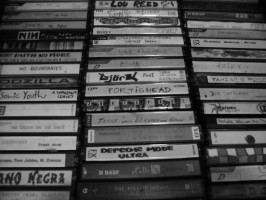 Upon first hearing buzz about mixtapes and The Walkman, many would grow nostalgic with images of something central to their youth, although some of those images may involve twirling a pen around the inner spool of the cassette to realign the tape.
Upon first hearing buzz about mixtapes and The Walkman, many would grow nostalgic with images of something central to their youth, although some of those images may involve twirling a pen around the inner spool of the cassette to realign the tape.
The more desired memories involve recording “tape letters” and splicing together clips from various songs as a message to a teenage crush. Above all, the tactile imagery created when remembering what it felt like to dig through a box of swollen and partially cracked tapes to find that one evokes a fond ache. Most are glad this has become only memory, though.
That oh-so-stylish hallmark of the ’80s has been rumored to be ‘making a comeback’ in the indie universe, but are cassette tapes really coming back into to the mainstream or is it more of a fad for collectors, nostalgics, and those who would like to save money on production and distribution costs?
The irony of various websites and blogs reporting on this so-called “comeback” lies in the October 25 statement by Sony that the company will no longer manufacture or market the cassette Walkman. This decision to kill the product after 30 years is due to the obsolescence of the format and the rise of the iPod and other digital devices.
Still, in the midst of audiences dependent on digital media and online access, a growing following of cassette enthusiasts exists. These fans are either collectors or artists who wish to give something special to their devoted fanbase. Something a little different and unique, where a plain old CD would not suffice. Let’s also not count out the “ironic hipster” factor when discussing the apparent resurgence of anything even remotely “vintage.” Keep in mind that the majority of modern tape releases are likely just collector’s items, as most fans probably no longer own the proper equipment to play back the format.
For today’s general population, where most people would more quickly do a Google search for cassette tape replication than actually travel to a local store, several sites offer replication service for anywhere from under $1.00 to just over $2.00 per tape depending on quantity ordered and length of cassette time (30 minutes is the standard). Such service providers include Tape Services, Inc., Amtech, and World Class Tapes, to name a few.
If you are planning a tape release, look for Church A/V suppliers, as well, since there is still a small niche market for cassettes in the Christian and Gospel music communities. You could also invest in a cassette duplicator and blank media (still readily available at the retail level), and just copy a short run yourself. Of course this is time consuming, but it’s the most DIY method. As far as the artistic quality of the insert, anything from a photocopied J-Card to original or one-off artwork will suffice. This adds to the DIY aesthetic of a piece of art to be passed along or treasured.
In 2008, Atlanta’s Deerhunter offered 100 copies of Island on cassette for those in attendance at their release party. This release was not made available in any other digital format. Even more recent releases of cassette material can be found from artists like Washed Out, another Georgia-based act who released High Times (2009) through the cassette label Mirror Universe.
Even grunge giants Pearl Jam re-issued their debut Ten in 2009 and included a replica of a three-song, “Momma-Son” demo cassette with Eddie Vedder’s original vocal dubs as part of the Super Deluxe Edition. This original demo served to unite the founding members of Pearl Jam and solidified their decision to meet in-person and work together.
When asked about the idea of the ‘comeback of the cassette’ and how it relates to the business of independent labels, Ron Scalzo, owner and founder of Bald Freak Music, responded, “CDs and cassettes just don’t capture that extra element that made albums like Deep Purple’s Burn, The Edgar Winter Group’s They Only Come Out At Night or Pink Floyd’s The Dark Side of the Moon that much more interesting to me. Cassettes were created strictly for convenience purposes and that convenience has been trumped countless times over by compact discs and then the dawn of the digital age. Vinyl is much sexier – it’s big and slim, it’s not plastic and stubby. Aesthetically, a record is a portrait – the care put into album artwork is the thing I truly miss most in the digital age.”
Because Scalzo has the added perspective of an artist and musician, he was able to further comment on the idea of releasing more economical versions of recorded material: “As an artist, I could see how the effect of releasing a professional ‘demo’ could be appealing to a music purist or a vintage junkie, but not beyond that. A cassette is essentially an 8-track’s sexy niece, but now she’s going gray, she’s lost her looks and has six kids and chain smokes.” Simply put, it’s not a listener’s format anymore, but as suspected, mostly just a collectable for die-hard fans.
The vintage market and hype will carry the supply while the artistic element of creating and marketing one-of-a-kind inserts makes releasing music on cassette a plausible DIY endeavor. Those who enjoy the freedom and creativity of making and distributing cassettes will continue to keep this stylish, if not low-fi, form of music alive and in hand. As a unique keepsake for an artist’s fans, the tape has certainly re-emerged as a contender in the past few years. But a true comeback? Not quite.
